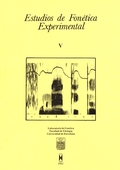Las transiciones y la percepción del punto de articulación en las oclusivas sordas: un estudio sobre el francés
Abstract
The aim of this paper was to determine the trade-off relationship among acoustic cues, i.e., the transitions of the preceding vowel, the burst, the transitions of the following vowel, or the relevance of an acoustic cue on the perception of French unvoiced stops. To that end utterances of two segments containing VCV sequences of two different unvoiced stops and the same type of vowel were produced. Stimuli integrated by two acoustic cues of a place of articulation and a conflicting cue of another place of articulation were made up through the splicing and editing of these VCV sequences. In addition, stimuli obtained by the splicing of the second syllable in each segment were carried out in order to test the role of the transitions in the preceding vowel. Listening tests through a panel comprising of 14 French speaking subjects were performed. Results showed that the trade-off relation of acoustic cues was the main information for the recognition of French unvoiced stops, although in few vowel contexts, listeners might be able to identifiy through one acoustic cue.
Downloads
Published
How to Cite
Issue
Section
License

This work is licensed under a Creative Commons Attribution-NonCommercial-NoDerivatives 4.0 International License.
All articles published online by Estudios de Fonética Experimental are licensed under Creative Commons Attribution-NonCommercial-NoDerivs 4.0 International (CC BY-NC-ND 4.0 DEED), unless otherwise noted. Estudios de Fonética Experimental is an open access journal. Estudios de Fonética Experimental is hosted by RCUB (Revistes Científiques de la Universitat de Barcelona), powered by Open Journal Systems (OJS) software. The copyright is not transferred to the journal: authors hold the copyright and publishing rights without restrictions. The author is free to use and distribute pre and post-prints versions of his/her article. However, preprint versions are regarded as a work-in-progress version used as internal communication with the authors, and we prefer to share postprint versions.




